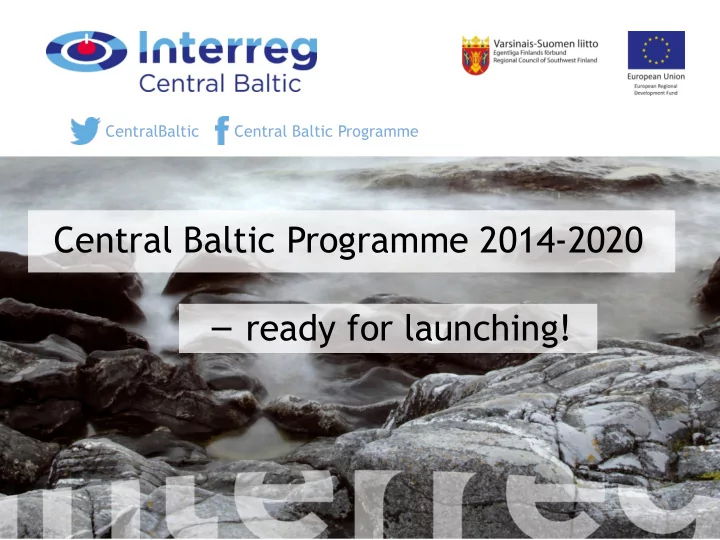

CentralBaltic Central Baltic Programme Central Baltic Programme 2014-2020 − ready for launching!
Welcome! • 5 events • 570 participants • Tallinn event on 12 November streamed online
How did we get here? • 6 JPC meetings with 46 people • 15 WG meetings with 30 people • 5 thematic seminars with 250 people • 4 public hearing events with 180 people • Comments from 30 people/organisations in public hearings
Where are we now? • The programme was submitted to the Commission in July • Approval expected in late 2014 • Programme draft on our website
Building on experience • Co-operations • Participating regions • Work done in projects • Lessons learned in the management of the programme
We are there for you – who are we? • Programme secretariat and management in Turku • Network of national Contact Points
WHAT’S NEW FOR 2014 -2020?
Focused programme We want to make a change for the region but we have limited funds and limited time focusing on the most relevant themes
Result orientation • We know what we want to achieve • Result and output indicators show if we’re on the right path • A key in allocating project funds • A key in showing the benefit of the programme • 2-step application procedure for regular projects
Chosen themes • Mix of old and new • ICT and low-carbon economy as horisontal objectives Competitive economy Sustainable use of of the region common resources Skilled and socially Well-connected region inclusive region
Programme basics • 115 million euros ERDF available • Co-finacing rates: • 75% (Finland & Sweden) • 85% (Estonia & Latvia) • Partners from at least two participating countries • Clear cross-border added-value • 2-step approach for regular projects • Small projects
Simplifications 1/3 • Online application and reporting • Reduced annexes • Widened eligibility of partners and their funding • Harmonized Implementation Tools • Small projects • 2-step call • Preparation costs
Simplifications 2/3 • Use of flat rate for office and rent costs • Possibility to use lump sums • Flexibility rule • 90-day deadline for payments • Advance payments • Merging MA and CA • 3 -> 2 reporting periods per year
Simplifications 3/3 • Setting deadlines for JS/MA work • Increased role for JS Contact Person • Raising limit for tenders • Closure period
WHAT TO THINK WHEN PLANNING A PROJECT?
Contribution to programme objectives • The focus has been chosen for a reason − now we all will implement it • Looking at the result and output indicators
Practical solutions • We want to achieve real results • The time for pure networking is over • Showing result in the region
Working on Learning from Networking joint problems each other /opportunities
The right partners • The technical eligibility has been widened • More focus on the relevance of the projects • The right partners needed to achieve results
Sustainable results • Value-for-money through real results • End-users should be involved • Plans for the use of results should be considered early on
COMING UP…
First call • Open on 18 December - 9 February • Small projects: decisions in April and projects can start in May • Regular projects: decisions on the first step in April and final decisions in August. Projects can start in September
Plan for calls • At least 2 calls for each Priority/Specific Objective • 1-2 calls/year as long as funding is available • Steering Committee selects projects for funding
Second call • Call open on 24 August-23 October 2015 • Small projects can start from February 2016 • Regular projects can start from July 2016
Third call • Third call: open in spring 2016 • Small projects can start from July 2016 • Regular projects can start from December 2016
Preparing and application • Programme Manual is available • Application form questions are available • Project development seminars • 18 December: Stockholm, Tallinn • 13 January: Helsinki, Riga • Consultations ongoing
Application form questions
Submitting an application • Templates launched in December • Guide for filling in the application launched in December • Lead Applicant fills in application • Deadline in eMonitoring System • Letters of intent • Confirmation Letter for Lead Applicant
eMonitoring System • Opened when the call is opened • Applications • Later project reporting • Uploading documents • Communication portal
Use us! • Project development seminars • Individual consultations • Contact Points in each country • Website (new in November) • Facebook and Twitter • Mailing list
Competitive economy Sustainable use of Well-connected Skilled and socially of the region common resources region inclusive region (29 meur) (37 meur) (37 meur) (12 meur) Access to and use and quality of ICT The shift towards a low-carbon economy Natural and cultural More people Improved transport New knowledge resources developed benefiting from flows of people and intensive companies into sustainable stronger CB goods tourist attractions communities More aligned Sustainably planned Improved services of More entrepreneurial vocational education and managed marine CB small ports for youth and training and coastal areas mobility and tourism programmes More exports by the Better urban planning Central Baltic companies in the Central Baltic to new markets region Reduced nutrients, hazardous substances and toxic inflows to the Baltic Sea
www.centralbaltic.eu CentralBaltic Central Baltic Programme Thank You!
Recommend
More recommend